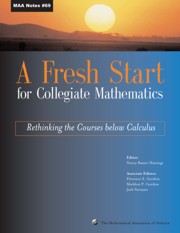Book contents
- Frontmatter
- Preface
- Contents
- Introduction
- Background
- Theme 1 New Visions for Introductory Collegiate Mathematics
- Theme 2 The Transition from High School to College
- Theme 3 The Needs of Other Disciplines
- Theme 4 Student Learning and Research
- 19 Assessing What Students Learn: Reform versus Traditional Precalculus and Follow-up Calculus
- 20 Student Voices and the Transition from Reform High School Mathematics to College Mathematics
- Theme 5 Implementation
- Theme 6 Influencing the Mathematics Community
- Ideas and Projects that Work: Part 1
- Ideas and Projects that Work: Part 2
20 - Student Voices and the Transition from Reform High School Mathematics to College Mathematics
from Theme 4 - Student Learning and Research
- Frontmatter
- Preface
- Contents
- Introduction
- Background
- Theme 1 New Visions for Introductory Collegiate Mathematics
- Theme 2 The Transition from High School to College
- Theme 3 The Needs of Other Disciplines
- Theme 4 Student Learning and Research
- 19 Assessing What Students Learn: Reform versus Traditional Precalculus and Follow-up Calculus
- 20 Student Voices and the Transition from Reform High School Mathematics to College Mathematics
- Theme 5 Implementation
- Theme 6 Influencing the Mathematics Community
- Ideas and Projects that Work: Part 1
- Ideas and Projects that Work: Part 2
Summary
Introduction
A variety of questions arise while trying to rethink college precalculus. How will students react to a reform precalculus experience? Can a reformed precalculus experience help students develop a broader and more realistic perspective of mathematics? How successful will students be in calculus if they have a different type of preparation? Can a different learning environment promote deeper mathematical understanding? Is it possible to create a classroom environment where students expect the mathematics to make sense and where they will struggle with complex problems?
None of these questions is easy to answer, but it is possible to begin to answer them by looking at the experiences of students who have prepared for college mathematics in a reformed environment. Over the past ten years, a growing number of high school students have prepared for college mathematics by studying high school mathematics in a reform environment. The changes in high school mathematics came about in response to poor national and international test results [1–3] and the National Council of Teachers of Mathematics (NCTM) Standards? documents [4, 5]. Beginning in 1992, the National Science Foundation (NSF) funded the development of several school mathematics curricula that would be in line with the vision of mathematics laid out in the NCTM documents. The curricula developed as a result of this funding are changing what is happening in many mathematics classrooms across the United States. One of the NSF curricula for grades 9–12 was developed by the Core-Plus Mathematics Project (CPMP) [6].
- Type
- Chapter
- Information
- A Fresh Start for Collegiate MathematicsRethinking the Courses below Calculus, pp. 193 - 210Publisher: Mathematical Association of AmericaPrint publication year: 2006

